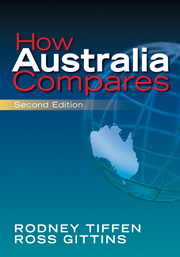Book contents
- Frontmatter
- Contents
- List of tables and figures
- Preface to the second edition
- Acknowledgements
- Reading the tables
- Abbreviations
- Introduction
- 1 People
- 2 Government and politics
- 3 Economics
- 4 Work and labour
- 5 Government taxes and spending
- 6 Health
- 7 Education
- 8 Inequality and social welfare
- 9 International relations
- 10 Environment
- 11 Science and technology
- 12 Telecommunications and computing
- 13 Media
- 14 Family
- 15 Lifestyles and consumption
- 16 Crime and social problems
- 17 The search for scoreboards
- 18 The Howard impact
- Sources and references
16 - Crime and social problems
Published online by Cambridge University Press: 05 June 2012
- Frontmatter
- Contents
- List of tables and figures
- Preface to the second edition
- Acknowledgements
- Reading the tables
- Abbreviations
- Introduction
- 1 People
- 2 Government and politics
- 3 Economics
- 4 Work and labour
- 5 Government taxes and spending
- 6 Health
- 7 Education
- 8 Inequality and social welfare
- 9 International relations
- 10 Environment
- 11 Science and technology
- 12 Telecommunications and computing
- 13 Media
- 14 Family
- 15 Lifestyles and consumption
- 16 Crime and social problems
- 17 The search for scoreboards
- 18 The Howard impact
- Sources and references
Summary
Crime rates
It may be a surprise – especially given the media and political attention given to crime – that Table 16.1 shows that crime rates have fallen in the selected countries overall, and sharply fallen in Australia. The table shows somewhat different timings and trajectories for different countries, but as a generalisation crime rose into the mid- or late 1990s, and then fell appreciably in the early years of the 21st century.
‘Crime and Social Problems’ is one of the sections of this book where the capacity of statistics to capture reality is most problematic. There are two main methods of measuring overall crime rates in different countries, both reported on the opposite page, but each has its own problems.
The best data, which are becoming steadily more valuable and illuminating, come from surveys of the public. The United Nations has co-ordinated five waves of the International Crime Victims Survey (ICVS) – 1989, 1992, 1996, 2000, 2004–2005 – to collect systematic comparative data on the experience of crime. In the fifth wave, all the selected countries participated, although participation was more uneven in earlier waves, as can be seen from the gaps in the table.
The advantage of this type of approach is that it involves large, broadly representative samples of the public, and asks them the same questions, thus overriding differences and inaccuracies in official data. It does rely on the accuracy of the sampling and the willingness of respondents to participate.
- Type
- Chapter
- Information
- How Australia Compares , pp. 214 - 229Publisher: Cambridge University PressPrint publication year: 2009



